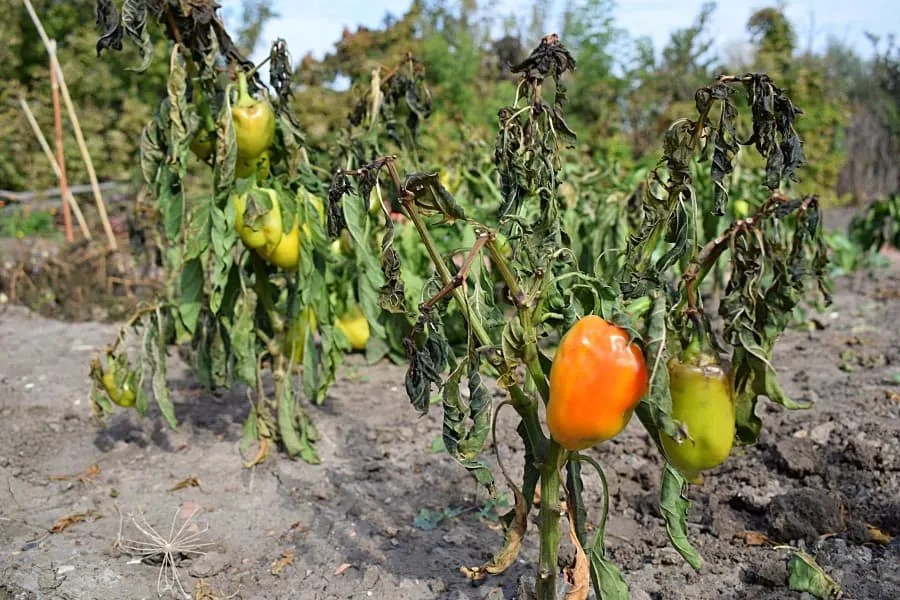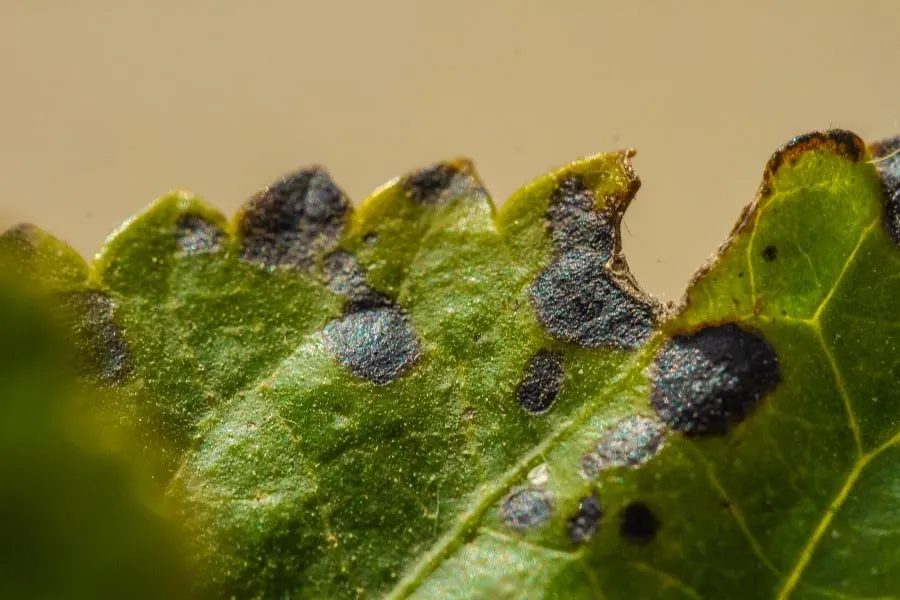Pepper plants are among the best species for first-time cultivators because they are easy to care for, undemanding, and extremely rewarding. However, sometimes, you might have to deal with some obstacles, like wilting, which can prevent you from enjoying delicious peppers on your dinner table. Luckily, in most cases, you can save your plant.
Your pepper plant might be wilting due to over- or underwatering, sun scalding, temperature issues, nutritional deficiency, or bacteria. To prevent wilting, expose pepper plants to sunlight (at least 6 hours), water when the soil is dry, ensure proper ventilation, and keep plants at 70-80℉ (21-26℃).
Recognizing the issue behind a wilting pepper plant is critical to find a prompt solution and save your plant. Find out all you need to know below.

Temperature Issues
Pepper plants thrive in average temperatures of 70-80 degrees Fahrenheit (21-26 degrees Celsius). Hot varieties can withstand higher temperatures over 85 degrees Fahrenheit (29 degrees Celsius). Because they are naturally warm-climate plants, it is essential to prevent freezing conditions and maintain a temperature above 60 degrees Fahrenheit (16 degrees Celsius).
At the same time, exposing your pepper plants to scalding temperatures for several hours every day can cause several issues to your plant, including wilting.
When you expose your plant to high temperatures, the moisture transpiration rate through the leaves increases. This results in your plant losing more water and nutrients than it can absorb from water and soil. In turn, the leaves can start yellowing, wilting, or drooping.
If this happens for long periods of time, the heat might cause your plant to suffer from sun burning and heat stress.
In this case, you should:
- Move your plant under the shade or cover it with a cloth.
- Continue watering your plant to replenish the lost nutrients.
- Continue monitoring the surrounding temperature.
- Delay pruning until your pepper plant has regained its health to avoid adding additional stress to your plant.
Water Issues
Among the most common issues behind wilting pepper plants are over- and underwatering. When looking after your pepper plant, keep in mind that these species prefer regular waterings and thrive in well-drained soil. Therefore, there is no “one-size-fits-all” formula.
- Overwatering can cause the plant’s soil to retain stagnant water, becoming a cradle for fungi and bacteria. For example, deathly issues such as root rot can derive from overwatering. Stagnant water might also surround the plant’s roots, preventing them from absorbing fresh oxygen and minerals.
- Underwatering can cause the plant’s leaves to wilt because the water pressure usually sustains them. Without it, leaves and stems won’t receive the necessary nutrients and pressure to remain lush and upright. If your pepper plant has just started wilting and the soil is dry, some water might be all that is needed to revive it.
While it can be challenging to find the right level of watering for your pepper plants, some simple tips can help you avoid issues such as wilting:
- Generally, you should provide your pepper plant with around 2 inches (5 cms) of water per week.
- Only water your pepper plants if the soil feels dry around 1 inch (2.5cm) below the soil’s surface—you can use the finger test for this (insert your finger about one inch deep and only water if the soil feels dry)
- Adjust the watering to the current temperature and climate. For example, you might have to compensate for lack of rain or increased temperatures.
Nutrient Issues
Depending on the look of your plant, wilting might be related to several nutritional deficiencies. The two most common ones include calcium or nitrogen deficiency.
- Calcium deficiency causes green or wrinkly leaves and is usually relatable to water stress, heat stress, or poor soil quality. Calcium deficiency is also responsible for blossom-end rot, which can prevent your plant from fruiting. You can add powdered eggshells to help boost calcium levels.
- Nitrogen deficiencies are often due to a lack of nutrients in the soil. Nitrogen is responsible for your plant’s foliage and leaves’ look. To resolve a nitrogen deficiency, pick a well-balanced fertilizer, but provide it in minimal quantities to not harm the plant’s fruits.

Bacteria and Diseases
Bacteria and diseases can cause your plant to wilt because they prevent nutrients, water, and oxygen from traveling through the plant and reaching all extremities.
In terms of bacteria and fungi, you might have to deal with Phytophthora blight and verticillium wilt. These diseases can quickly spread across several pepper plants and different species in your crop, so your best move is to remove the affected plant, so that other plants don’t get infected. In this case, you might need to use a bactericide.
Pest Infestations
Pests can also cause pepper plants to wilt. Some of the common pests your pepper plants might have to contend with:
- Spider mites
- Stink bugs
- Thrips
- Flea beetles
- Pepper maggots
- Aphids
Many of these pests will feed on the plant’s sap or nutrients, preventing the plant from benefiting from them. Pests can represent a severe issue because they can multiply quickly and even transfer from a plant to another. You can use different organic methods to protect your pepper plants from pests.
How to Fix Your Pepper Plant’s Wilting Problems
When it comes down to saving your wilting pepper plant, remember that, in most situations, all you will need to do is change one of the plant’s environmental conditions, such as light exposure, temperature, or moisture. Depending on which one of the issues is causing your plant to wilt, will require the right solution.
In the video below, you can learn all you need to know about the different pepper plants’ specific requirements:
Can You Fix Your Plant After it Has Started to Wilt?
In most cases, you can save your pepper plants from wilting by adjusting the water level or moving them to a shaded or sunnier spot. However, if you are dealing with diseases such as root rot, it might be too late to save your plant. In this case, it is recommendable to immediately remove any affected leaves and plants to prevent further spreading.
Four Ways to Prevent Pepper Plants from Wilting
As we have seen, wilting can be due to several causes. Here are some tips to prevent wilting in pepper plants:
- Keep the leaves off the soil to prevent bacterial infections. You can do so by removing dead or dying leaves before they accumulate at the bottom of the plant.
- Add mulch around the pepper plant’s base. This technique will help you regulate how much water the plant receives. In high-temperature climates, it can help the soil retain essential nutrients.
- Water the plant according to the temperature, moisture, and exposure to sunlight. Use your finger to test the soil to see if watering is necessary.
- Make sure to act quickly if you see your pepper plant wilting to prevent further damage.
Closing Thoughts
Pepper plants are hardy, resistant plants that can withstand a range of environments and growing conditions. However, it is not uncommon to notice their leaves wilting or yellowing at some point during your plants’ lives. In most cases, this issue is related to underwatering or overwatering—situations that you can resolve by adjusting the watering or providing additional drainage.
However, sometimes, you might be dealing with diseases and bacteria. In this case, you should consult an expert cultivator to find bactericidal or pesticide substances. Make sure to separate your pepper plant from others in your crop to prevent the spreading of diseases.
Here are Some of my Favorite Gardening Products and Tools
Thank you for reading this article. I hope you found it helpful for growing some new plants in your home or garden. Here are some products I like that I hope you’ll also find helpful. These are affiliate links, and I am compensated for referring traffic. But in all honesty, these are the exact product that I use or recommend to everyone.
Soil: For high-quality soil, I really like Fox Farm Ocean Forest. I do all my growing in containers and this soil has worked great for me. I like how they use nutrient-rich contents like earthworm castings, bat guano, and composted crab and fish.
Fertilizer: Currently I am using a seaweed-based organic fertilizer call Neptunes Harvest. This is a great milder fertilizer option if you want to use something organic. If you want a more powerful fertilizer, I recommend Fox Farm Liquid Nutrient Trio, lots of people have had great growing success with this product.
Pruning Shears: Pruning shears are one of the most useful gardening tools to have because it’s important to prune your plants to keep them healthy. The pruning shears I recommend are the Gonicc 8’’ pruning shears. I like them because they are built sturdy and work both on bigger and smaller plants, so you don’t need to have multiple pruning shears.
spicytrio.com is a participant in the Amazon Services LLC Associates Program, an affiliate advertising program designed to provide a means for sites to earn advertising fees by advertising and linking to Amazon.com. spicytrio.com also participates in affiliate programs with other sites. spicytrio.com is compensated for referring traffic and business to these companies.
